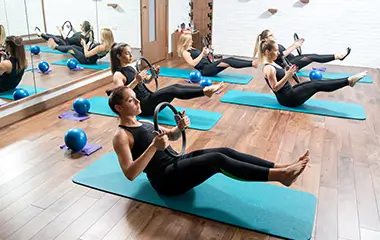Price is, of course, more than just a number; price is also a way of sending a message about what your service is trying to be. Is your gym to be a gold plated no-expense spared offering? Or a basics-and-essentials only? The number attached to the ticket helps your customers decide how to think about your gym offering and where it sits in the marketplace.
Supermarkets understand the positioning principle very well and we can learn a lot from the way their brands operate.
But what is the right price for your gym memberships? How do you determine it?
Olie who runs Bromely fitness center outside London in the UK has spent a little time working out his pricing.
“We’ve got a much more inspiring atmosphere than the mass Puregym level and our clientele really notice that. But we also want to say we are more affordable than say Virgin who are doing wetside facilities, so that’s how we set our price band.”
Olie’s pricing structure seems to be working for him, and the young entrepreneur is looking to open another gym next year.
Here is a guide so you can maximize both sales and profits.
What is the average pilates club membership price?
Prices vary, depending on the studio, region and type of membership. We took a look at pilates studios in the US in early 2025, and this is what we found to be the average membership options and their prices:
- Single Class (Drop-In): $25 to $85
- 4-Pack Classes: $84 per month
- 8-Pack Classes: $149 per month
- 10-Pack Classes: $229 per month
- One Month Membership: $150 to $200 per month
- Two-Month Membership: $140 to $160 per month
- All-Access: $199 per month
Some studios charge a modest enrollment fee, while others don’t.
Annual pilates club memberships range from $1,250 – $11,550. Our research showed All-Access membership as the cheapest plan, where members can participate in one class per day.
What different types of membership work best?
Here are some popular types of fitness membership based on duration and perks:
Monthly memberships
In monthly memberships, you charge your members on a monthly basis. All the perks you add to your monthly membership plans are valid for them. Usually, there are two types of monthly membership:
- Unlimited monthly membership: Club members get unlimited access to facilities and classes for a month. This is a perfect choice for members who want to keep their fitness journey undisturbed.
- Limited monthly membership: This type of membership includes a limited selection of facilities and classes.
Annual memberships
These memberships are billed on a yearly basis and allow members access to classes and amenities for all 12 months. There are two common types of annual membership:
- Full cost, 12-month membership: It covers both limited and unlimited class access plans and is normally cheaper than monthly membership plans.
- Student or seniors discounted annual membership: These memberships are tailored specifically for seniors or students with discounts. They may include some limits on the type of classes or number of places in each class, for example.
Class packages
There are generally two types of class packages:
- Drop-in classes: Members can buy them for one time or a set number of classes, which makes them more feasible for occasional visitors who do not need recurring membership.
- Class bundles: Another way of offering multiple classes in a single package with no recurring fee. You can offer discounts on bulk purchases of your pilates classes.
Hybrid memberships
A hybrid membership combines in-studio and virtual classes. It can be offered as a monthly or annual package.
Family memberships
These allow multiple family members to share a membership, offering cost savings for families who want to train together.
Specific perks and time limits can vary from one studio to another.
Your club membership pricing strategy
Here are some of the most important considerations to help you set your prices:
Understand your target audience
Research other studios in the area, and ask prospective customers what they would be willing to pay. With a good understanding of needs and preferences, you can choose membership structures that are appealing and competitive.
Calculate all your operating costs
One of the key factors that you should be pondering while setting up your club membership cost for members is the accumulation of total annual expenses. You should be breaking down operational costs, including;
- Rent and facility expenses
- Instructor salaries and overheads
- Equipment maintenance
- Insurance
- Marketing and other administrative costs
Analyze the market
Take a careful look at your competitors in the area. What are they charging, how busy are they, what feedback can you see about them? You might spot gaps in the market, and opportunities to win an edge over your competitors.
Pricing strategies
There are different pricing strategies that you should consider when setting membership prices:
Cost-plus pricing
This is relatively simple, and involves adding a percentage to the total cost of providing the studio’s services, such as instructor salaries, equipment, rent, and overhead costs, to determine the membership price. It helps the studio cover all its costs and also makes a profit.
Value-based pricing
This depends on the perceived value of the services offered by the studio. It encompasses what the customers are willing to pay to receive the benefits and quality. You could charge premium prices for enhanced facilities, qualified instructors, or exclusive servicing.
Dynamic pricing
This is where fees vary according to demand, season or time of day. Dynamic pricing helps to maximize revenue by adjusting to dynamic market conditions and customer demand. It can also be used to manage capacity during periods of high traffic.
Tiered membership options
This involves having options where different benefits go hand in hand with different price packages. Customers can choose the package that best suits their needs and budget. For example:
- Basic: Offers the essentials at a low cost.
- Premium: Provides additional benefits like priority booking or access to premium classes.
- Premium Plus: Includes all the premium features and more, catering to the most dedicated customers.
Setting prices
To determine what membership rates to offer, there are other factors to consider:
Balance profitability and affordability
The price should ideally not be too high or too low.
Offer competitive introductory rates
An introductory rate refers to a special, low price offered to new members for their first class/experience at the studio. The rate is set to encourage prospective members to test the services.
It is very important to provide the lowest introductory rate to new clients. It gives them the chance to get into the studio without spending a lot of money. This may constitute the initial stage of building a customer base and cultivating ongoing relationships.
Create incentives for a long-term commitment
Incentives could include loyalty programs, discounts for annual memberships, or additional perks for long-term commitments.
Long-term members provide stability and consistent revenue for the studio. Incentives for commitment not only retain existing members but also reduce the likelihood of members moving to competitors. They contribute to the studio’s financial health and can enhance the sense of community among members.
Build in pricing adjustments and promotions
These help monitor changes in demand such as whether there is regular class attendance, hence optimal revenue.
Review and adjust prices regularly
Every club pilates studio should regularly review and adjust prices. This means reviewing the pricing structure regularly to make sure it is still competitive, in tune with the market, and reflects the value the studio provides.
Set up promotions, discounts, and special offers
Promotions and special offers are short and time-limited, either to retain existing members, attract new members, fill classes at off-peak times or to encourage members to book early. They might include price reductions, package deals, free classes or exclusive access.
Offer member referral incentives
Most studios offer incentives such as discounts or free lessons to both the referring and new members.
Word-of-mouth marketing and trust between members are used with referral programs. They can be very useful in attracting new clients at low acquisition costs. They encourage members to become advocates for the studio, promoting a sense of community.
Conclusion
Smart pricing for your club starts with understanding your target customers and your competitors. Decide what value you’re offering to different customers, and what your members want to pay for.
The approaches we discuss here are:
Most common types of memberships:
- Monthly – unlimited, limited
- Annual – full membership, student or senior discounts
- Class packages – drop-in, class bundles
- Hybrid – in-studio and virtual classes
- Family packages
Important considerations:
- Understand your target audience
- Calculate all your operational costs
- Analyse the market
Pricing strategies:
- Cost-plus pricing
- Value-based pricing
- Dynamic pricing
- Tiered membership options
How to set prices:
- Balance profitability and affordability
- Offer competitive introductory rates
- Create incentives for a long-term commitment
- Build in pricing adjustments and promotions
- Review and adjust prices regularly
- Set up promotions, discounts and special offers
- Offer member referral incentives





